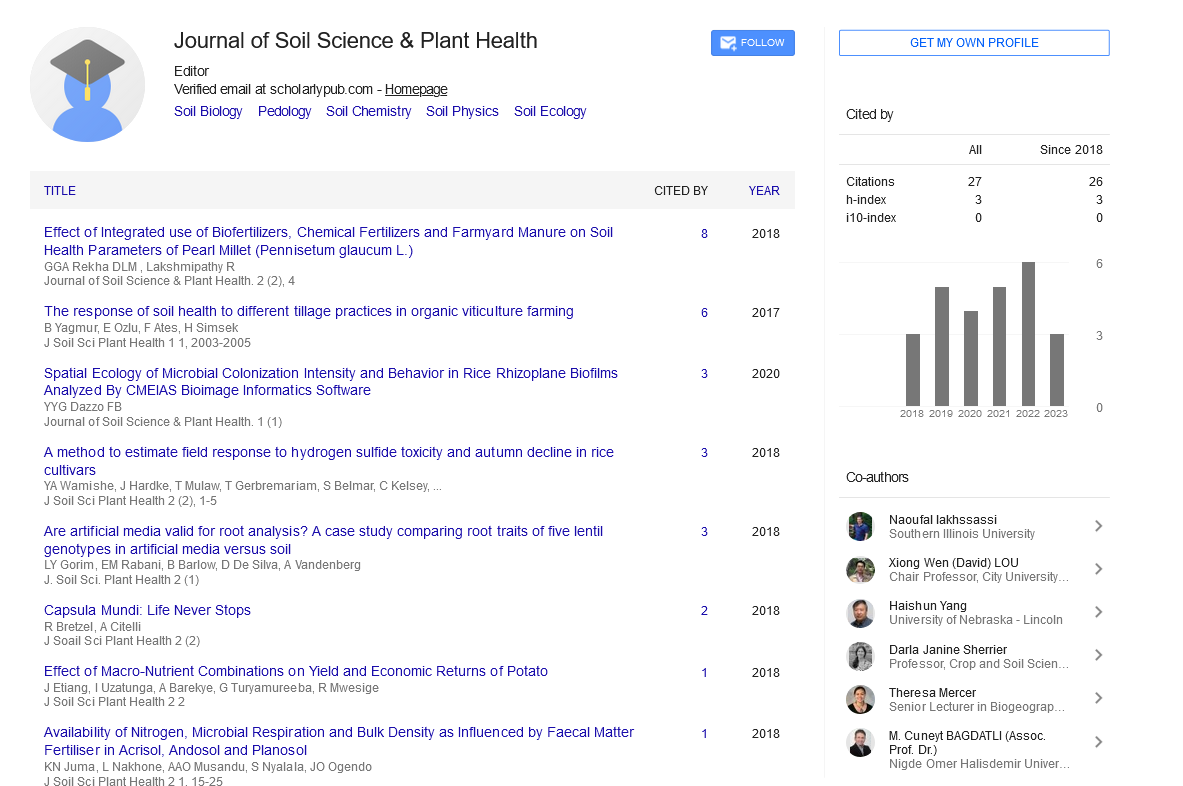Commentary, J Soil Sci Plant Health Vol: 5 Issue: 8
Plant Surface by Enzymatic Discharges of the Microorganism
Pujitha Krishi*
Department of Microbiology, University of Gujarat, Gandhinagar, Gujarat, India
*Corresponding author: Dr. Pujitha krishi, Department of Microbiology, University of Gujarat, Gandhinagar, Gujarat, India, Email: krishi@ind.com
Received date: August 02, 2021; Accepted date: August 16, 2021; Published date: August 23, 2021
Keywords: Hyphae, Polymorphic protection, Plant-microbe
Introduction
Plant-microbe connection is a multi-layered cycle, interceded by the microorganism and plant-determined atoms which fundamentally incorporate proteins, sugars and lipopolysaccharides. Emitted atoms, gotten from the microbes, are the key variables which decide their pathogenicity and permit their fruitful colonization inside the host. Then again, plant inferred particles are associated with the acknowledgment of these microbes to get the protection reaction. The principal collaboration between the plants and microorganisms occur in apoplast and is intervened by the acknowledgment of microbial elicitors by the receptor proteins of the plants. Plants cover the most space of the world's living climate as trees, grasses, blossoms, etc. Plants assume diverse significant parts in the climate, for example, environment equilibrium and food supplement for creatures and people. Besides, wild or developed plants are viewed as the incredible bio fertilizers for the dirt, where the plant garbage after death and corruption furnishes the dirt with adequate natural issue. Likewise, plant care is an extraordinary obligation and hard mission, which should be continually improved. The investigation of plant microbes has a place with the part of science known as plant pathology. The last is likewise worried to defeat the plant sicknesses emerging from the biotic as well as abiotic beginning. Biotic illnesses are created attributable to microbial contamination, while abiotic (non-infectious) infections are created because of ecological variables. In this part, we are worried about plant microorganisms or phytopathogenic organisms like microbes, infections, growths, mollicutes, etc. Plant microbes are, by and large, small microorganisms that can't matter a "willful" power to a plant surface. Just a few organisms, parasitic higher plants, and nematodes seem to apply mechanical strain to the plant surface they are going to enter. The measure of pressing factor, in any case, may change significantly with the level of "presoftening" of a plant surface by enzymatic discharges of the microorganism. For growths and parasitic higher plants to enter a plant surface, they should, for the most part, first stick to it. Hyphae and radicles are typically encircled by adhesive substances, and their attachment to the plant is by all accounts achieved fundamentally by the intermolecular powers creating between the surfaces of plant and microbe on close contact with the sticky substances and with each other. Now and again an attachment cushion structures from the spore when it interacts with a damp surface, and cutinase and cellulose chemicals delivered from the spore surface assist the spore with following the plant surface. Spores of certain growths convey sticky substances at their tips that, on hydration, permit spores to become joined to different surfaces. Albeit a few microbes might utilize mechanical power to enter plant tissues, the exercises of microorganisms in plants are to a great extent compound in nature. Hence, the impacts brought about by microorganisms on plants are essentially the consequence of biochemical responses occurring between substances emitted by the microbe and those present in, or delivered by, the plant. The principle gatherings of substances discharged by microorganisms in plants that appear to be associated with creation of infection, either straightforwardly or in a roundabout way, are proteins, poisons, development controllers, and polysaccharides (stopping substances). These substances shift incredibly regarding their significance in pathogenicity, and their overall significance might be not quite the same as one illness to another. In this manner, in certain infections, like delicate decays, proteins appear to be by a long shot the most significant, though in illnesses, for example, crown nerve, development controllers are evidently the fundamental substances included. In any case, in the Bipolarise scourge of Victoria oats, the infection is fundamentally the consequence of a poison emitted in the plant by the microbe. Proteins, poisons, and development controllers, likely in a specific order, are significantly more normal and presumably more significant in plant infection improvement than polysaccharides. It has additionally been shown that a few microorganisms. In many plant microbe cooperation’s, have plants have polymorphic protection from various strains or races of microorganism which is constrained by a solitary quality. Illness obstruction constrained by passive qualities is frequently an aloof type of opposition wherein the microbe can't use have cell apparatus. Predominant obstruction (R) qualities in plants appear to effectively perceive the presence of explicit microbes and start modified reactions to neutralize contamination. Notwithstanding, this obstruction is subject to the microbe having a relating quality that coordinates with the R quality. These microbe virulence qualities are additionally prevailing over their related harmful alleles. Since the result of an endeavoured contamination is subject to the genotype of both host and microbe.
 Spanish
Spanish  Chinese
Chinese  Russian
Russian  German
German  French
French  Japanese
Japanese  Portuguese
Portuguese  Hindi
Hindi 